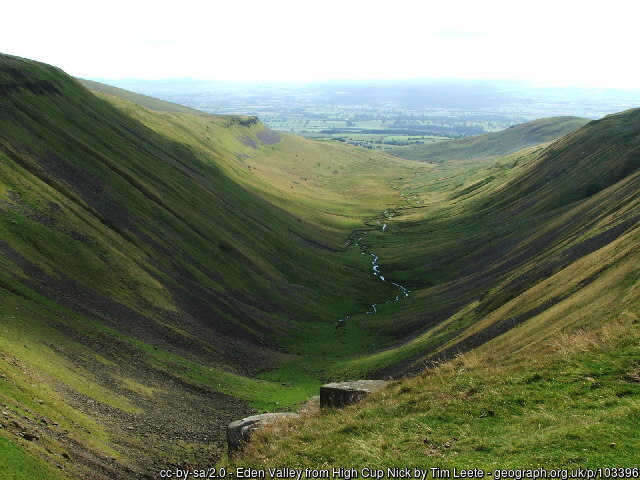The Eden Valley in east Cumbria is underlain by Permo-Triassic sandstone, the major aquifer in north-west England. The aquifer is covered by low permeability till deposits. Concern about rising nitrate trends in some boreholes has prompted collaborative research into groundwater flow systems and timescales in the area.

Location of the Eden Valley in northern England. BGS © UKRI.
Land use influence on water quality
The use of slurry and artificial fertilisers following agricultural intensification in the area during the 1980s is believed to be responsible for the rise in nitrate concentrations. BGS undertook research to enable prediction of future nitrate concentrations at abstraction boreholes and in groundwater discharge to surface water.

The Eden Valley as seen from High Cup Gill in Cumbria. ©Tim Leete and licensed for reuse under this Creative Commons Licence.
How old is the groundwater at depth ?
Deuterium and bromide tracers showed that water travelled through the low permeability till at a rate of about 1 to 2 m/year where the till was less than 2 m thick. The results for thicker till were harder to define.
The groundwater towards the bottom of a 90 m borehole was found to be about 60 years old, so it had fallen on the ground as rainfall some time around 1950.
Sampling and analysis
This study considered a theoretical ‘flowpath’ from upland outcrop to discharge zone at the River Eden.
We undertook hydrochemical profiling in the unsaturated zone using agricultural tracers and dating groundwater in a cored borehole. The hydrochemistry (particularly nitrate) of samples from discrete intervals in the profile was compared with the proportion of modern water (and year of recharge) and was found to be strongly related to the age of the water.
Below the water table, we employed a combination of:
- porewater sampling during air-flushed borehole coring
- discrete interval sampling using a slimline packer system
- geophysical logging
- downhole digital imaging
- ‘modern’ water dating techniques (CFC and sulfur hexafluoride)
- hydrochemical analysis
Physical and hydrochemical profiles were developed and key fractures or fracture zones were identified and formed the basis of focused sampling.


Further reading
Butcher, A, Griffiths, K, Lapworth, D, Humpage, A, and Burke, S. 2009. Investigation of rising nitrate concentrations in groundwater in the Eden Valley, Cumbria. 4, estimating recharge rates through glacial till using an applied tracer technique. British Geological Survey Open Report OR/09/059. (Nottingham, UK: British Geological Survey.)
Butcher, A, Lawrence, A, Jackson, C, Cullis, E, Cunningham, J, Hasan, K, and Ingram, J. 2006. Investigating rising nitrate concentrations in groundwater in the Permo-Triassic aquifer, Eden Valley, Cumbria, UK. 285–296 in Fluid Flow and Solute Movement in Sandstones: the onshore UK Permo-Triassic red bed sequence. Barker, R D, and Tellam, J H (editors). Geological Society of London Special Publication 263. (London, UK: Geological Society of London.) DOI: https://doi.org/10.1144/GSL.SP.2006.263.01.16
Contact
Please contact BGS Enquiries for more information.

